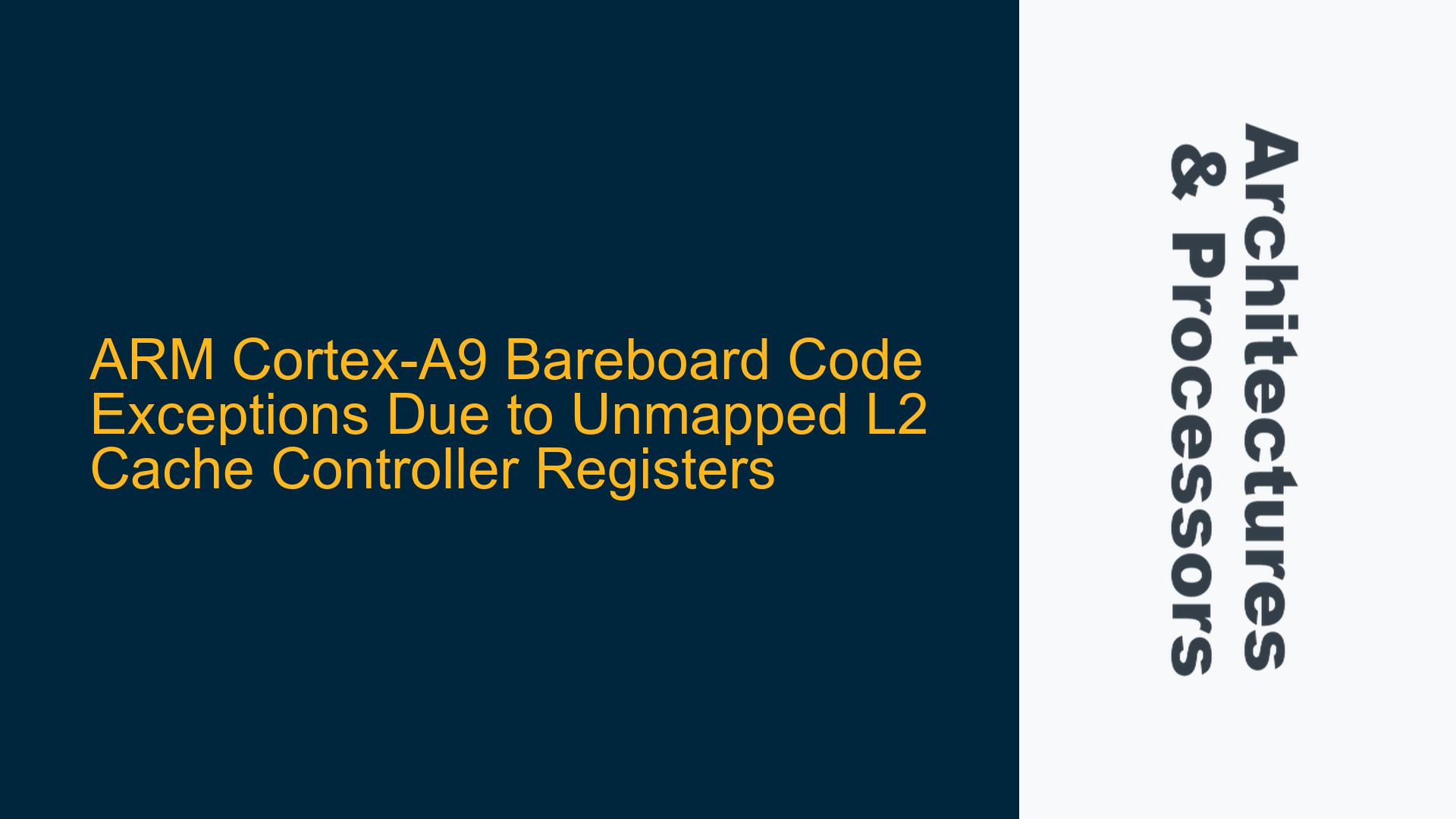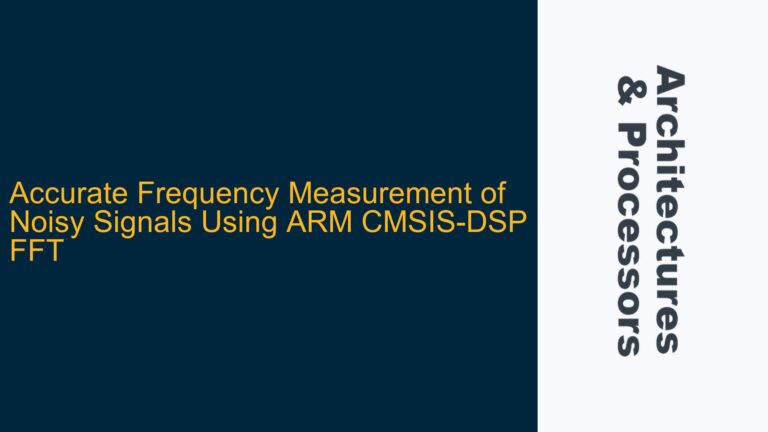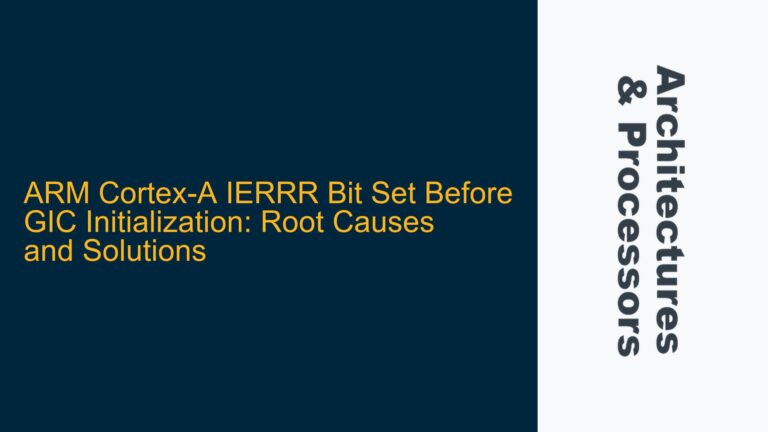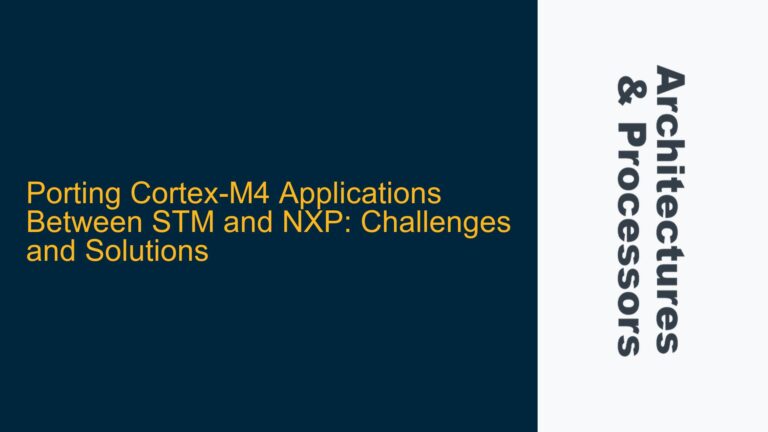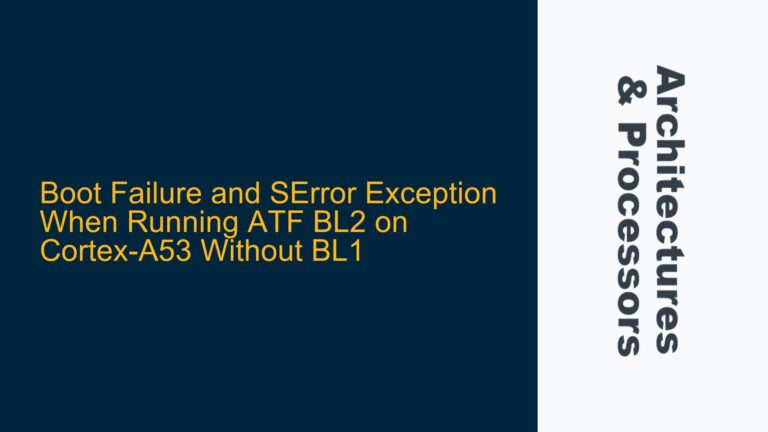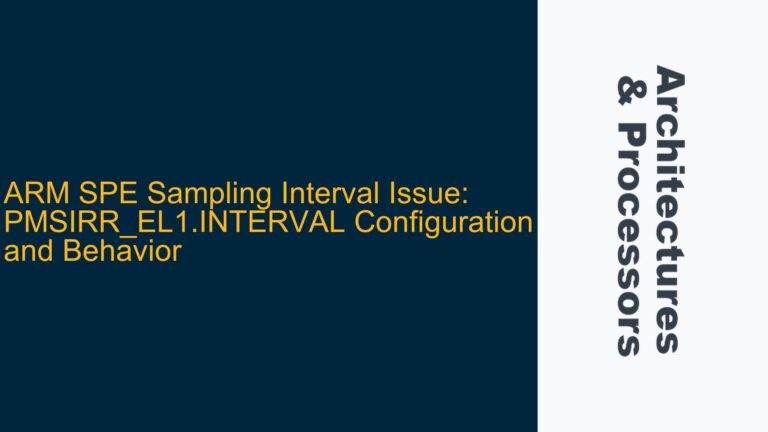ARM Cortex-A9 MMU Enablement and L2 Cache Controller Mapping Anomalies
When working with ARM Cortex-A9 processors, particularly in bareboard environments, enabling the Memory Management Unit (MMU) can introduce subtle and complex issues if the L2 cache controller registers are not properly mapped. In this scenario, the system throws random exceptions, primarily Data Aborts, even when both L1 and L2 caches are disabled. The peculiar behavior observed is that simply mapping the L2 cache controller’s memory-mapped register space in the MMU, without enabling the cache, resolves these exceptions. This suggests an underlying interaction between the MMU, the L2 cache controller, and the memory subsystem that is not immediately obvious.
The Cortex-A9’s L2 cache controller, specifically the L2C-310, plays a critical role in managing cache coherence and memory transactions. Even when the cache is disabled, the controller’s registers must be accessible to the processor to ensure proper system operation. The absence of this mapping can lead to unpredictable behavior, such as register corruption and subsequent Data Aborts. This issue is particularly pronounced in systems where the MMU is enabled, as the MMU’s translation tables must correctly map all necessary peripheral and controller registers to avoid access violations.
Understanding the root cause of this behavior requires a deep dive into the ARMv7-A architecture, the Cortex-A9 implementation, and the specific interactions between the MMU, cache controllers, and the memory subsystem. The following sections will explore the possible causes of these exceptions and provide detailed troubleshooting steps to resolve the issue.
Data Aborts and Register Corruption During MMU Enablement
The primary symptom of the issue is the occurrence of random Data Abort exceptions after enabling the MMU. These exceptions are often accompanied by register corruption, particularly in general-purpose registers like r3. The corruption of r3 is significant because it typically holds valid memory addresses used in load/store operations. When r3 is corrupted, subsequent memory accesses using this register result in Data Aborts, as the addresses become invalid or point to inaccessible memory regions.
The Data Abort exceptions are not directly related to the L2 cache controller’s functionality, as the cache is disabled. However, the act of mapping the L2 cache controller’s registers in the MMU appears to stabilize the system, preventing these exceptions. This suggests that the L2 cache controller’s register space, even when not actively used, plays a role in maintaining system stability. The exact mechanism behind this behavior is not well-documented, but it likely involves the processor’s internal memory subsystem and its interaction with the MMU.
One possible explanation is that the Cortex-A9’s memory subsystem performs background operations or checks related to the L2 cache controller, even when the cache is disabled. If the MMU does not have a valid mapping for the L2 cache controller’s register space, these operations may fail silently, leading to undefined behavior and eventual system instability. This hypothesis is supported by the observation that mapping the L2 cache controller’s registers resolves the issue, even though the cache remains disabled.
Another factor to consider is the alignment requirements of the ARMv7-A architecture. The Cortex-A9 requires strict alignment for certain operations, particularly those involving the Floating Point Unit (FPU). While the core itself does not mandate 8-byte stack alignment for non-leaf functions, the Embedded Application Binary Interface (EABI) does. Misalignment can lead to subtle issues, including register corruption and Data Aborts. However, in this case, the alignment issue is less likely to be the primary cause, as the problem is resolved by mapping the L2 cache controller’s registers, not by adjusting stack alignment.
MMU Configuration and L2 Cache Controller Register Mapping
The resolution to this issue lies in ensuring that the MMU’s translation tables correctly map the L2 cache controller’s register space. The L2C-310 controller’s registers are memory-mapped, meaning they occupy a specific range of physical addresses. When the MMU is enabled, it translates virtual addresses to physical addresses based on these translation tables. If the L2 cache controller’s register space is not mapped, any access to these registers (even indirect or background accesses) will result in a translation fault, leading to a Data Abort.
To prevent this, the MMU’s translation tables must include an entry for the L2 cache controller’s register space. This entry should map the virtual address range corresponding to the L2 cache controller’s physical address range with the appropriate memory attributes. These attributes typically include cacheability, shareability, and access permissions. For the L2 cache controller’s registers, the memory attributes should be set to non-cacheable, strongly ordered, and with full read/write access permissions.
The process of mapping the L2 cache controller’s registers involves the following steps:
-
Identify the Physical Address Range: Determine the base address and size of the L2 cache controller’s register space. This information is typically found in the processor’s reference manual or the system’s memory map.
-
Define the Virtual Address Range: Choose a virtual address range to map to the L2 cache controller’s physical address range. This range should not conflict with other mapped regions in the MMU’s translation tables.
-
Set Memory Attributes: Configure the memory attributes for the mapped region. For the L2 cache controller’s registers, set the region to non-cacheable, strongly ordered, and with full read/write access permissions.
-
Update the MMU Translation Tables: Add an entry to the MMU’s translation tables that maps the chosen virtual address range to the L2 cache controller’s physical address range with the specified memory attributes.
-
Enable the MMU: Once the translation tables are updated, enable the MMU. The system should now have stable access to the L2 cache controller’s registers, preventing the random Data Abort exceptions.
By following these steps, the system can achieve stable operation even with the MMU enabled. The key takeaway is that the L2 cache controller’s registers must be mapped in the MMU’s translation tables, regardless of whether the cache is enabled or disabled. This ensures that the processor’s internal memory subsystem can access these registers without causing translation faults or other undefined behavior.
Conclusion
The issue of random Data Abort exceptions in ARM Cortex-A9 bareboard code, particularly after enabling the MMU, is a complex problem that highlights the intricate interactions between the MMU, cache controllers, and the memory subsystem. The resolution involves ensuring that the L2 cache controller’s registers are correctly mapped in the MMU’s translation tables, even when the cache is disabled. This mapping stabilizes the system by providing the processor with the necessary access to the L2 cache controller’s register space, preventing translation faults and register corruption.
Understanding and addressing this issue requires a thorough knowledge of the ARMv7-A architecture, the Cortex-A9 implementation, and the specific requirements of the L2C-310 cache controller. By carefully configuring the MMU’s translation tables and ensuring proper memory attribute settings, developers can achieve stable and reliable operation in bareboard environments. This approach not only resolves the immediate issue but also provides a foundation for further optimization and system tuning.
